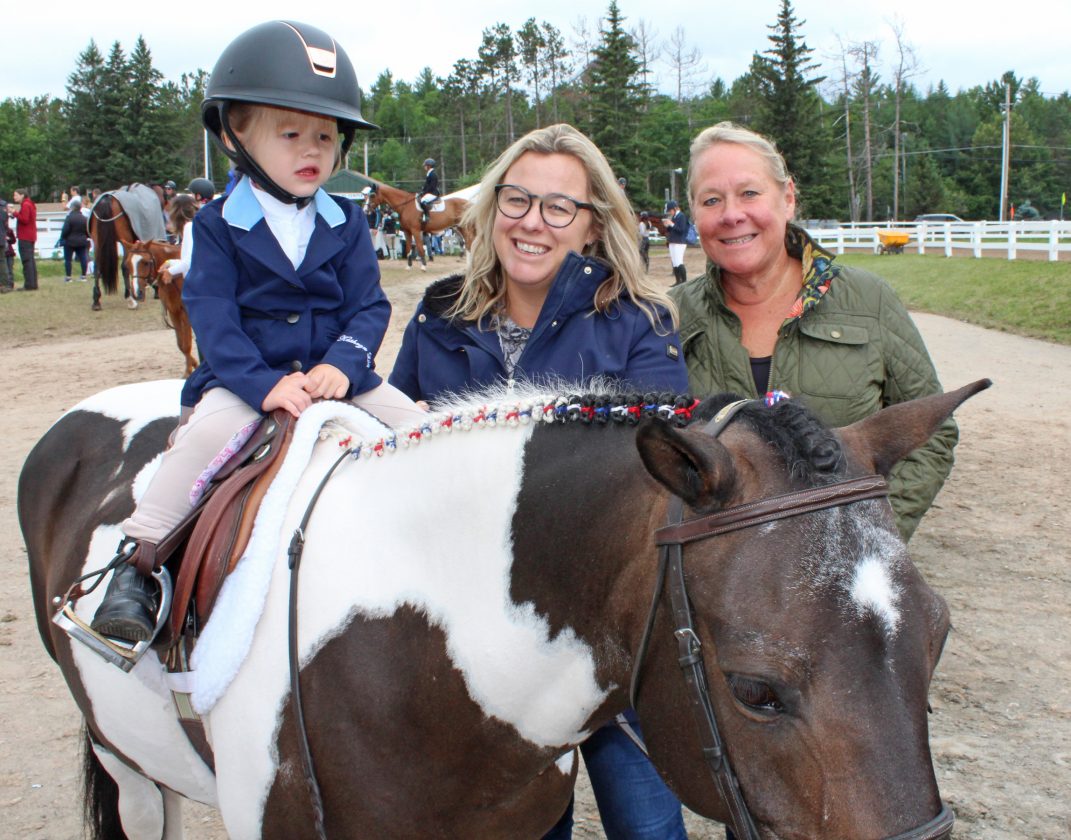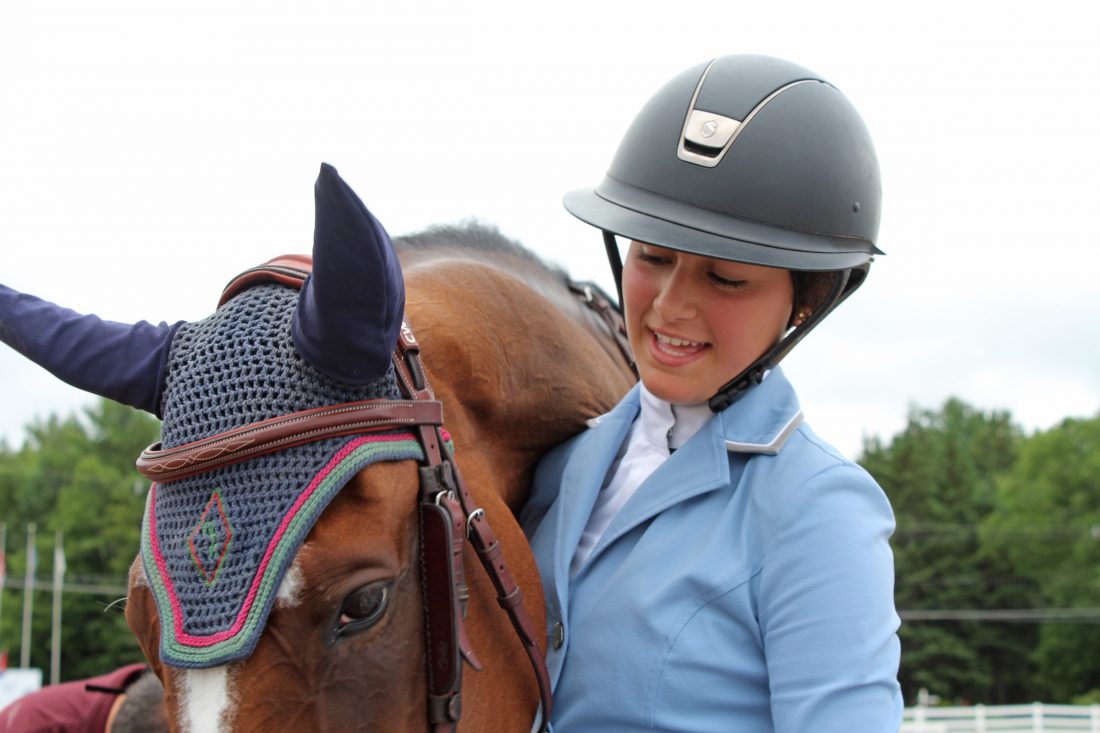ON THE SCENE: Lake Placid Horse Shows return

Daisy, 2 years old, sits on Color Up Sunday, July 4 during the Lake Placid Horse Show’s Juliam Farm Lead Line Class with her mom Chelsea Dwinell and grandmother Kimberly Dwinell. (Provided photo — Naj Wikoff)
On Sunday, July 4, every parking spot at the Lake Placid Horse Show was taken. There was an energy throughout the venue as if a large champagne bottle had popped its cork.
Last year in Lake Placid and throughout much of the United States, similar competitions had closed to due to coronavirus pandemic restrictions. So this year people were thrilled to get out and connect with long-missed friends, associates and competitors. As a means of encouraging the horse show community to return, organizers announced they would be following CDC guidelines and bringing in two of the finest course designers in the world, Alan Wade and Ken Krome.
Wade and Krome are both Federation Equestre Internationale-rated course designers, with the Tipperary, Ireland-based Wade having designed several FEI World Cup Equestrian Games courses. Krome, one of the finest U.S.-based designers, is also sought after as a USEA-rated judge.
Owners and riders come to Lake Placid because it provides a wide range of high-quality competitions in a family-friendly setting. During their down time, attendees can swim and boat on the lakes, shop on Main Street, drive up the Whiteface Mountain highway, experience the Cliffside Coaster at Mount Van Hoevenberg and dine in a variety of restaurants. Several participants who have come for years have bought camps on Lake Placid or seasonal homes in the town and village.
“It’s awesome to have it starting up again,” said Lori Martin, executive director of the Lake Placid Horse Show Association. “It’s great to see everybody. We’re full, and everything has gone fairly smoothly. The setup was a little difficult due to COVID, getting equipment, supplies and things like that. We follow CDC guidelines. Right from the start, equestrian event protocols were lightened a bit because everyone is outside so much, and they stay spread out.”

Lori, Butch and Lorissa Martin pose Sunday, July 4 at the Lake Placid Horse Show. Lori is the executive director of the Lake Placid Horse Show Association, and Butch is the manager of the North Elba Park District, which maintains the North Elba Show Grounds. (Provided photo — Naj Wikoff)
Another attraction of the horse show is that the venue meets the highest standards, an outcome of critical investments in the footing, the surface upon which much of the competitions take place. Like other top shows, Lake Placid’s footing provides a firm cushion when the horses land, one that drains quickly and is not slippery when wet; rather, it provides a firm grip and a good rebound.
In addition, the caliber of the course design and competition, coupled with having a grass grand prix stadium, are big draws. In the U.S., more horse shows have switched to an all-level footing. While Lake Placid has that for most of stadiums, it’s grand prix is grass, as is found throughout Europe. A grass surface is not level; it undulates, which makes it trickier to design and compete on. As a consequence, on tennis terms, Lake Placid is to most U.S. horse shows what Wimbledon is to tennis.
“This is my first time in Lake Placid,” said Wade, who began his career as a rider and for the last 40 years has been designing world-class courses. “It’s an absolutely great place. I like the weather because it’s a bit like home. I brought my raincoat, so I’m prepared. I try to design a test that’s fair and will allow the rider with the best combination of skills to win. I enjoy working on grass, though it’s a lot harder because of the mix of assets. It’s challenging. There’s a bit of slope to every fence you lay out. With level footing, you can just follow a plan. With grass, you have to be careful. Basically, a horse’s stride is considered 12-foot, so you lay it out in multiples of 12, allowing for differences in a stride on an up or downhill slope. Downhill, the stride will be a little bit longer and uphill a little bit shorter.”
“I am ready to ride,” said Daisy, age 2, preparing for the Juliam Farm Lead Line class held between Sunday’s grand prix stadium competitions.
“She always likes to ride,” said Chelsea Dwinell. “Our very nice friend Bonnie gave us a lovely pony to use today, Color Up, who was the champion in the Short Stirrup Division. Daisy has a pony, actually a miniature horse. She’s been riding since she was in her mom’s belly. Her dad’s jumping in the grand prix.”

From left are Lake Placid Horse Show Association Vice Chairman Tim Hooker and Chairman Phillip Richter. (Provided photo — Naj Wikoff)
Like Alpine ski racing and golf — and unlike sports like baseball, football and hockey — in show jumping there’s no defensive actions; it’s all about the athlete dealing with a set course and changing conditions caused by the weather, which can happen while on the course. An added challenge is dealing with a horse, a 1,200-pound animal that can muck up the most skilled rider.
Zayna Rizvi, 16, riding Excellent, demonstrated she had it takes winning with alacrity the High Jr. A-O Jumper Classic held in the Richard Feldman Grand Prix Ring. Now in her fifth season of riding in Lake Placid, Rizvi said that her love for horses inspired her to take up show jumping. She credits her success to the connection she has with her horses.
“I’ve been riding since I was 3,” said Rizvi. “I love it. I love Lake Placid, too. The view is amazing here, and I like how you can go to the lake when you’re done showing. That’s super fun. And I love showing on the field; it’s huge, probably one of the biggest fields I’ve shown on, and I think the horses love it, too.”
On the opposite end of the experience scale is Michael Matz, the multiple Lake Placid Grand Prix winner, Olympic silver medalist, and trainer of 2006 Kentucky Derby winner Barbaro who came to Lake Placid to support is son Alex, who ended up winning the Richard Feldman Grand Prix on Sunday.
“I was first drawn to the sport because of the competition and the idea that a 150-pound person could navigate a 1,200-pound horse around the course using two thin little strips of leather,” said Matz. “You do it right, and it looks easy. You do it wrong, it could become pretty difficult. The thing with horses, you are always dealing with two personalities, the rider and the horse. You have to make sure your horse is condition on race day to perform, and the rider also. It’s challenging, but fun also. Lake Placid is different because it’s so family friendly and the grand prix ring is grass that isn’t level.”

From left, Alex Matz, who won the Richard Feldman Grand Brix on July 4 riding Cashew CR, poses with his father Michael Matz, who won a silver medal in the Olympics, has won multiple Lake Placid grand prix winners and trained 2006 Kentucky Derby winner Barbaro. (Provided photo — Naj Wikoff)
An added winner was Butch Martin. Lake Placid Board Chair Phillip Richter brought Martin out to the center of the Grand Prix Ring and presented him with an award created in 2018 by the board to recognize officials who have given so much to the success of the horse shows. Martin’s name is now the third inscribed on the permanent trophy.
The I Love New York Horse Show began on Tuesday, July 6 and runs through Sunday, July 11.
(Naj Wikoff lives in Keene Valley. He has been covering events for the News for more than 15 years.)

Zayna Rizvi and Excellent were winners the 2021 High Jr. A-O Jumper Classic Grand Prix at the Lake Placid Horse Show. (Provided photo — Naj Wikoff)




